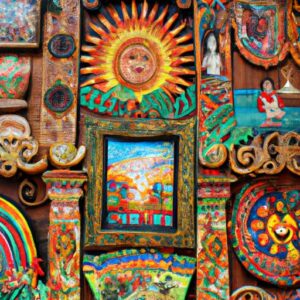Contemporary art, a dynamic and ever-evolving realm of creative expression, encompasses a myriad of art forms that push boundaries and challenge traditional notions. Among these art forms, music emerges as a powerful and influential medium, shaping the artistic landscape in profound ways. In this article, we will delve into the interconnection between music and contemporary art, exploring the significance of music within this vibrant artistic realm.
Definition of Contemporary Art
Contemporary art encompasses a wide range of artistic practices that reflect the societal, cultural, and technological context of the present time. It includes various mediums such as painting, sculpture, performance art, installation, and digital art. With its emphasis on experimentation, conceptualization, and engagement with contemporary issues, contemporary art defies conventional norms and opens up new avenues for artistic exploration.
Significance of Music in Contemporary Art
Music, as an integral part of the human experience, has always played a crucial role in cultural expression. In the realm of contemporary art, music holds immense significance as it transcends boundaries and connects with audiences on a deep emotional level. It has the power to evoke profound feelings, provoke thought, and challenge societal constructs. Music brings a unique dimension to contemporary art, enriching the overall artistic experience and fostering a multisensory engagement with the audience.
Thesis Statement: Exploring the Interconnection between Music and Contemporary Art
In this article, we will explore the interplay between music and contemporary art, investigating how music has become an integral part of this artistic domain. By examining the historical evolution of contemporary art, the role of music as an expression of artistic vision, the impact of technology on music in contemporary art, controversies surrounding its inclusion, and the future prospects, we aim to unravel the intricate relationship between music and contemporary art.
As we embark on this journey, we invite you to delve into the vibrant world where music intertwines with contemporary art, shaping and redefining the artistic landscape in ways that ignite our imagination and challenge our perceptions. Are you ready to explore the harmonious symphony of art and music? Let’s dive in together!
The Evolution of Contemporary Art
A. Brief Historical Overview of Contemporary Art
Contemporary art has undergone a fascinating evolution, shaped by various artistic movements and cultural shifts throughout history. It emerged as a response to the changing socio-political landscape and the desire to break free from traditional artistic conventions. The birth of contemporary art can be traced back to the late 20th century, with the advent of movements such as Abstract Expressionism, Pop Art, and Minimalism. These movements challenged the established norms of art, paving the way for experimentation and innovation.
B. Expansion of Art Forms in Contemporary Art
One of the defining characteristics of contemporary art is its expansive nature, encompassing a wide array of art forms. While traditional mediums like painting and sculpture continue to thrive, contemporary artists have expanded their repertoire to include performance art, video art, installation art, and more. This expansion has allowed artists to explore new avenues of expression and engage with audiences in innovative ways.
C. Emergence of Music as an Artistic Medium in Contemporary Art
Music, with its ability to evoke emotions and transcend language barriers, has found a natural home in contemporary art. In recent decades, we have witnessed the emergence of music as a powerful artistic medium within the contemporary art world. Musicians collaborate with visual artists to create immersive installations, where sound and visuals intertwine to create a multisensory experience. This integration of music and visual art challenges traditional boundaries and blurs the lines between different artistic disciplines.
The evolution of contemporary art has been marked by a constant desire to push boundaries and explore new artistic possibilities. As music finds its place within this ever-expanding artistic landscape, it contributes to the rich tapestry of contemporary art, adding a layer of sonic resonance and enhancing the overall artistic experience. Join me as we delve deeper into the interplay between music and contemporary art, uncovering the ways in which music shapes and influences this vibrant artistic realm.
Music as an Expression of Artistic Vision
In the realm of contemporary art, music serves as a powerful tool for artists to express their artistic vision, transcending boundaries and resonating with audiences on both emotional and intellectual levels. Let’s explore the various aspects of music as an expression within contemporary art.
Music as a Tool for Emotional and Intellectual Expression
Music has a unique ability to evoke and communicate emotions that words alone often struggle to convey. Artists harness this power by integrating music into their works, creating a multisensory experience that connects with viewers on a profound level. Whether it’s a haunting melody, a pulsating rhythm, or a delicate harmony, music adds depth and complexity to the artistic narrative, amplifying the intended emotional impact.
Moreover, music within contemporary art serves as a conduit for intellectual expression. Through carefully crafted compositions, artists can explore abstract concepts, challenge societal norms, and provoke thought. Music becomes a language of ideas, allowing artists to communicate complex themes and narratives that resonate with audiences in a profound and thought-provoking manner.
Role of Music in Conveying Social and Political Messages
Throughout history, music has played a vital role in conveying social and political messages. In the realm of contemporary art, music continues to be a powerful medium for artists to address pressing societal issues. From protest songs to politically charged compositions, music becomes a platform for artists to voice their opinions and inspire change.
By blending music with lyrics or using instrumental compositions, artists create works that carry powerful messages, urging viewers to reflect, question, and engage with the world around them. Music becomes a catalyst for social and political discourse, igniting conversations and inspiring action.
Integration of Music with Visual Arts in Contemporary Installations
Contemporary art often blurs the boundaries between different artistic mediums, and the integration of music with visual arts is a prime example of this interdisciplinary approach. Artists seamlessly merge music and visual elements, creating immersive installations that captivate the senses and challenge traditional artistic conventions.
Through the use of soundscapes, live performances, or audiovisual collaborations, artists create dynamic and interactive experiences where music becomes an integral part of the visual narrative. This integration not only enhances the overall aesthetic appeal of the artwork but also deepens the viewer’s engagement, fostering a multisensory and holistic artistic experience.
In the next section, we will explore the impact of technology on music in contemporary art. Join me as we uncover how technological advancements have revolutionized the relationship between music and the artistic realm.
The Impact of Technology on Music in Contemporary Art
Technology has revolutionized the music industry, bringing forth new possibilities and avenues for artistic expression within the realm of contemporary art. In this section, we will explore the profound impact of technology on music in contemporary art, examining the exploration of digital and electronic music in art, the utilization of technology in music production and performance, and the collaborations between artists and musicians in the digital age.
Exploration of Digital and Electronic Music in Art
Digital and electronic music have emerged as prominent forms of artistic expression within contemporary art. Artists now have access to a vast array of digital tools and software, enabling them to create intricate soundscapes and experiment with innovative musical styles. From sampling and synthesizers to computer-generated compositions, digital technology has expanded the boundaries of music in contemporary art, allowing artists to explore new sonic territories and push the limits of creativity.
Utilization of Technology in Music Production and Performance
Technological advancements have revolutionized the way music is produced and performed in contemporary art. Recording studios have evolved into digital workstations, offering artists a myriad of possibilities for manipulating and refining their sound. Additionally, advancements in live performance technology have allowed musicians to incorporate visuals, interactive elements, and immersive experiences into their shows. Technology has become a powerful tool that enhances the artistic vision, enabling musicians to create captivating performances that seamlessly integrate with other art forms.
Collaborations between Artists and Musicians in the Digital Age
The digital age has fostered collaborations between artists and musicians, blurring the boundaries between different artistic disciplines. Artists and musicians now join forces to create immersive installations, multimedia performances, and interactive experiences. These collaborations leverage technology to merge visual art, music, and other mediums, resulting in hybrid creations that captivate and engage audiences in new and exciting ways. The collaborative nature of contemporary art allows for a cross-pollination of ideas, sparking innovative approaches and pushing the boundaries of artistic expression.
As technology continues to evolve, the impact on music in contemporary art will undoubtedly remain significant. The exploration of digital and electronic music, utilization of technology in production and performance, and collaborations between artists and musicians in the digital age are just a glimpse of the transformative power technology holds within the realm of contemporary art. Through these advancements, music becomes an integral part of the multisensory experience, pushing the boundaries of artistic expression and captivating audiences in unprecedented ways.
Controversies Surrounding Music in Contemporary Art
A. Criticism of Music’s Place in Traditional Art Institutions
Within the realm of traditional art institutions, there has been a longstanding debate surrounding the place of music as a legitimate art form. Critics argue that music, being an auditory medium, lacks the tangible and visual qualities traditionally associated with visual arts. This viewpoint often questions the inclusion of music within art galleries and museums, as it challenges the conventional boundaries and definitions of art. However, proponents of music in contemporary art argue that it is precisely this boundary-pushing nature that makes it a vital component of the artistic landscape, enriching artistic experiences and broadening the horizons of viewers.
B. Debates on the Authenticity and Commercialization of Music in Art
Another controversy surrounding music in contemporary art revolves around questions of authenticity and commercialization. Some argue that the integration of music into art installations and exhibitions is a mere marketing strategy, aimed at attracting a wider audience and increasing profits. This viewpoint raises concerns about the dilution of artistic integrity and the commodification of music within the art world. On the other hand, proponents argue that the collaboration between musicians and visual artists can lead to innovative and thought-provoking creations, blurring the boundaries between disciplines and challenging preconceived notions of what constitutes “authentic” art.
C. Challenges Faced by Musicians in Establishing their Artistic Identity within the Contemporary Art World
Musicians who venture into the realm of contemporary art often face unique challenges in establishing their artistic identity. The traditional music industry may not fully embrace their experimental and boundary-pushing work, leading to a struggle for recognition and acceptance. Additionally, musicians may encounter difficulties in navigating the art world, which operates on different structures and hierarchies compared to the music industry. However, the fusion of music and contemporary art also provides musicians with opportunities for interdisciplinary collaborations and the exploration of new creative avenues, allowing them to forge their own path and redefine the boundaries of their artistic expression.
As the intermingling of music and contemporary art continues to provoke debates and challenge established norms, it is crucial to engage in thoughtful discourse that embraces the diversity of perspectives. By acknowledging and addressing these controversies, we can foster a more inclusive and dynamic artistic landscape that celebrates the interplay between music and contemporary art.
Conclusion
In conclusion, the interconnection between music and contemporary art is undeniable. Music has become an integral part of the ever-evolving realm of contemporary art, enriching the artistic experience and pushing boundaries. Throughout this article, we have explored the significance of music in contemporary art, examining its role as an expression of artistic vision, the impact of technology on music, controversies surrounding its inclusion, and the future prospects.
Music has proven to be a powerful tool for emotional and intellectual expression within contemporary art. It allows artists to convey their artistic vision, evoke emotions, and communicate complex ideas to the audience. The integration of music with visual arts in contemporary installations creates multisensory experiences that immerse the viewers in a realm of aesthetic wonder.
The impact of technology on music in contemporary art cannot be overstated. The advent of digital and electronic music has opened up new possibilities for artistic experimentation and collaboration. Artists and musicians now have access to advanced tools and techniques that expand their creative horizons, enabling them to create groundbreaking artworks that merge various art forms seamlessly.
However, the inclusion of music in contemporary art has not been without controversies. Critics question its place within traditional art institutions, while debates on authenticity and commercialization persist. Musicians face challenges in establishing their artistic identity within the contemporary art world, as they navigate the intersection of music and visual arts.
Looking ahead, the future of music in contemporary art is promising. As technology continues to advance, we can expect further innovation and exploration in the merging of music and other art forms. The interplay between music and contemporary art will continue to shape the artistic landscape, challenging conventions and inspiring new generations of artists.
In the harmonious symphony of art and music, we find a boundless realm of creativity and expression. So, let us embrace the interconnection between music and contemporary art, celebrating the power of this dynamic duo to inspire, provoke, and captivate our senses. Together, they forge a path towards endless artistic possibilities, inviting us to experience the beauty and creativity that lies at the heart of contemporary art.





